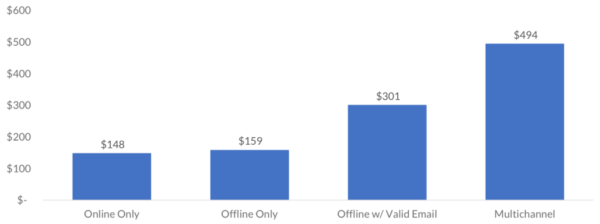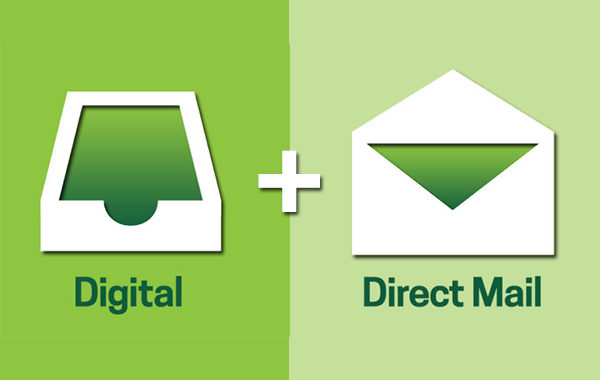Editor’s Note: The following is a guest post from Brady Josephson (@bradyjosephson) from Next After. Brady and Next After are the main people I pay attention to in digital fundraising. They are scientists, creating hypothesis and then rigorously testing to see what works in fundraising today. I love their approach, and I’ve witnessed it work for a nonprofit that we both serve.
Direct mail isn’t dead, and it won’t be for a while; but its upside is limited, and there is a general decline. That doesn’t mean you need to stop what you’re doing and invest in a Snapchat strategy – please don’t.
It does mean that you should be looking at ways to use online communications and cheaper, digital strategies to get the best return from your direct mail spending. That’s integrated fundraising, and it can be quite valuable.

Our data — from our client benchmark group — shows that offline donors who simply receive email communication give 90% more than offline donors who don’t get emails.
And if those offline donors give online as well, then their giving is over 3x more than people who only give online or offline.
It’s these numbers and data points that show the need to integrate your fundraising, or send the same or similar message to donors both online and offline. There may be a fear that it’ll be overly expensive or they will cannibalize each other, but that’s just not true. They help one another.
We call this multichannel fundraising strategy “horizontal integration,” as you are trying to do the same thing across channels:

Now that’s great – and you should be doing this – but today I want to talk about a new strategy for you to try: vertical integration.

This is where you can leverage the unique benefits of each channel to add to the value of the other channels and, in the end (or later on in another channel), total revenue overall. So with that, here are…
Two Proven Strategies to Raise More Money Without Sending More Mail
1. Show Facebook Ads to Your Direct Mail Donors
In this experiment, we spent just under $1,000 on Facebook ads and targeted half of the direct mail file. As long as you have an email and/or phone number, you can create a pretty targeted audience in Facebook to show ads to. This is one reason why I’m a big fan of Facebook ads.
Anyways, these ads were shown two weeks before the direct mail piece dropped, and for two weeks after. The ads weren’t focused on donations but focused on other benefits like a free online course.
Here were the results:
Those that saw the ads gave 154.5% more than those that did not.
No more mail. Very little cost. Pretty big lift.
And then someone who saw this experiment at our Nonprofit Innovation and Optimization Summit decided to run this experiment for themselves.
They spent just under $700 Canadian — so, practically nothing — and showed video ads 1 week before the drop date and 3 weeks after. Again, the focus of the ads was not donations.
Here were the results:
Those that saw the ads gave 25.4% more than those who did not.
The $690 investment in Facebook ads resulted in about $10,000 more revenue. Not bad.
2. Create ‘Priming’ Content Leading Up To Your Ask
Great stewardship and year-round communications are important, but using focused content in closer proximity to your drop date and key asks can help boost results. This concept is called ‘priming,’ and it can be very effective.
Take this experiment, where we send out a personalized postcard to half of the donor file with a link to a custom thank you video two weeks before they were to receive an appeal. The result?
Those that received the postcard were three times more likely to give, with a 204.09% increase in conversion/donation rate.
Postcards are pretty cheap, and if they can help you get that type of lift it could be well worth it. Well worth testing, at the very least.
In another experiment, we tried something similar but used digital content to ‘prime’ donors. Over a few weeks leading up to year-end, articles focused on the need for funds, the impact they’ll have, and how generosity is good and useful were created and published on the organization’s blog.
It’s key to note that those articles did not have a link to a donation page or any ask in them at all. And here were the results:
Those that saw the priming content gave 185.3% more than those who did not.
So even if you don’t have the budget to send a personalized postcard, you can certainly publish an article or content that shows the need, impact, and generosity.
It’s key to note that in each experiment, the content was created/sent two weeks before the key ask date. If you prime too early, it can lose its effect as donors won’t remember (subconsciously); and if you don’t do it soon enough, then you may not have enough time to expose the donor to your content.
So…
Absolutely you should be looking at how you can horizontally integrate your fundraising with a big emphasis on email (getting and sending). But you should also explore vertically integrating your fundraising to make the most of cost-effective digital tools and channels to boost offline and total revenue.
Good luck!
— Brady Josephson (@bradyjosephson)
Steven Screen is Co-Founder of The Better Fundraising Company and lead author of its blog. With over 30 years' fundraising experience, he gets energized by helping organizations understand how they can raise more money. He’s a second-generation fundraiser, a past winner of the Direct Mail Package of the Year, and data-driven.









One comment on “How To Raise More Money Without Sending More Mail”